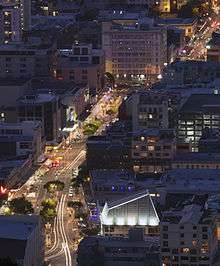Courtenay Place, Wellington
 Courtenay Place at night, view from Mount Victoria | |
| Maintained by | Wellington City Council |
|---|---|
| Length | 450 m (1,480 ft) |
| Location | Te Aro, Wellington, New Zealand |
| East end | Cambridge Terrace/Kent Terrace/Marjoribanks Street |
| West end | Taranaki Street/Manners Street/Dixon Street |
Courtenay Place is the main street of the Courtenay Quarter in the Wellington, New Zealand inner-city district of Te Aro.
Courtenay Place is known for its entertainment and nightlife. Many restaurants are open late and most of the bars stay open until dawn. It contains offices, accommodation, tourist shopping, entertainment, food, art and buskers offering many genres of free performance. Pedestrian traffic is substantial around the clock.
Early Development
The first building of any importance in Courtenay Place was built shortly after 1900 by local butcher and businessman, John Rod JP.[1] It is now a heritage listed building, originally designed by T S Lambert, situated on the eastern corner of Allen Street and Courtenay Place. Of brick construction, it originally had three stories and a large cellar, with stables at the rear (now 23 Allen street).[2] It has since been reduced to two stories, probably due to earthquake damage. In 2015, the ground floor and cellars accommodate a bar and restaurant.
The arts
Every two years Courtenay Place is home to many of the New Zealand International Arts Festival events. The richness of Courtenay Place culture inspires many artists, including photographers, professional and amateur alike.
Bats Theatre is New Zealand's leading venue for the development of new theatre practitioners and plays.
Downstage Theatre, founded in 1964, is New Zealand's first professional theatre.
Embassy Theatre The Lord of the Rings movie The Return of the King had its world premiere at the Embassy Theatre at the head of Courtenay Place. The movies The Two Towers and The Fellowship of the Ring both had their Australasian premiere at the Embassy (Event Slide Shows). Both events were broadcast live to the world for many hours, involving the movement of record amounts of data by CityLink. The theatre is on the Wellington City Council's heritage list in the District Plan. The New Zealand Historic Places Trust has recognised its heritage values with Category One registration, indicating a place of 'special or outstanding historical or cultural heritage significance or value'. It was originally known as the 'De Luxe' and was built in 1924. Designed by Llewellyn Williams and constructed of reinforced concrete, it included classical external and internal architectural details. The name changed to the Embassy in 1945. A long list of theatre identities has been associated with the theatre, including William Kemball, who formed the De Luxe Theatre Company in 1923, and Sir Robert Kerridge. Kerry Robins, leaseholder of the Paramount Theatre in Wellington, took over the lease of the Embassy in 1996. It was purchased by the Embassy Theatre Trust in 1997 with financial underwriting of the refurbishment programme by Wellington City Council. Ownership was transferred to the WCC under the terms of the agreement. Embassy Theatre Trust subsidiary Company Financial report: Audit report In October 2005 Wellington film exhibitor Kerry Robins sold the operational management of the Embassy to Village SkyCity Cinemas.
Paramount Theatre, 25 Courtenay Place. The Paramount is the oldest surviving cinema in Wellington, still with its original name. Originally a part of Te Aro beach, in August 1916 the location of the Paramount was purchased by John James Williamson. He arranged for architect James Bennie to design a picture house.
Reading Cinema Complex, 100 Courtenay Place. The $23m complex contains shops, restaurants and a ten-screen multiplex cinema. The 8,000 m² development links Courtenay Place with the waterfront and was designed to complement the existing character of the strip. This project won the 2003 Property Council NZ Entertainment Excellence Award. The site was originally bulldozed in the mid-1980s by Chase Corporation for an unspecified development, but after the company fell victim to the 1987 sharemarket crash, the site remained derelict for years until it was purchased by Reading Cinemas.
The Film Archive (Te Anakura Whitiahua) is on the corner of Ghuznee St and Taranaki St, a block from Courtenay Place.
St James Theatre, 83 Courtenay Place. Formerly His Majesty's (and more recently the Westpac St James Theatre), the St. James was designed for John Fuller and Sons Ltd by Mr Henry Eli White Architect, structural engineer and contractor. It was the first steel-framed concrete-coated proscenium-arched theatre in the Southern Hemisphere. The steel frame allowed for an unsupported 80 ft (25 m) span roof structure and also provided good resistance to earthquake damage.
In July 2011, Positively Wellington Venues, an integration between the Wellington Convention Centre and the St James Theatre Trust, began managing this theatre as well as The Opera House, Wellington.
There are two other theatres that sit just outside the Courtenay Place district, Circa Theatre which sits on the waterfront near Te Papa; and Capital E, home of the National Theatre for Children, which is in Civic Square.
Gallery
 An overhead view of Courtenay Place
An overhead view of Courtenay Place Courtenay Place cinemas
Courtenay Place cinemas Courtenay Place, leading up to the Embassy Theatre.Rod's building (built 1902)is first left (pink).
Courtenay Place, leading up to the Embassy Theatre.Rod's building (built 1902)is first left (pink).
References
External links
| Wikimedia Commons has media related to Courtenay Place, Wellington. |
Coordinates: 41°17′37″S 174°46′54″E / 41.2936°S 174.7816°E